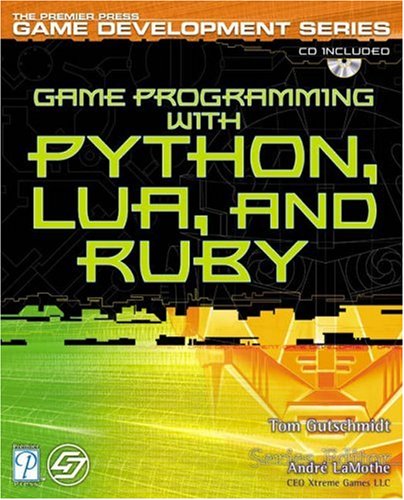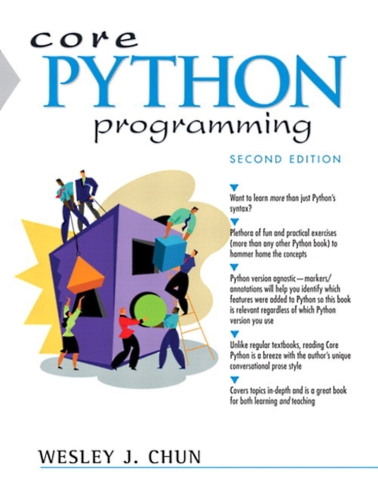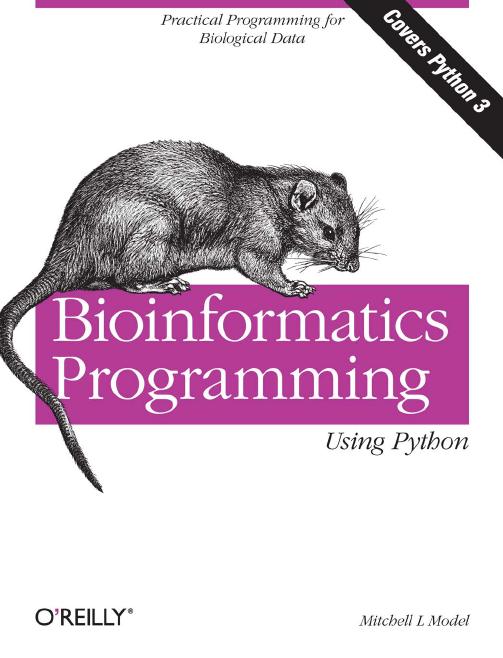|
|
Каталог файлов
В категории материалов: 64
Показано материалов: 11-20 |
Страницы: « 1 2 3 4 ... 6 7 » |
Сортировать по:
Дате ·
Названию ·
Рейтингу ·
Комментариям ·
Загрузкам ·
Просмотрам

Год выпуска: 2003
Издательство: Premier Press
Автор Tom Gutschmidt
ISBN: 1-59200-079-7
Формат: PDF
Качество: eBook
Количество страниц: 458
Описание: This book is written for programmers of all skill levels. Some readers will want to jump immediately to a specific section, while others will want to read the book in a linear fashion. To make it easy, each language section starts with a chapter of introduction that covers the basics of syntax and style and then follows up with chapters in which I'll go into more depth. Each language is presented in a similar way, so that it is easy to skip around and hit the sections in the book that interest you most. |

Год выпуска: 2009
Автор: Wesley J. Chun Издательство:Prentice Hall ISBN:978-0-13-226993-3 Формат: PDF Количество страниц: 1120
Описание: This book differs from other Python books on the market by presenting a broad range of topics, providing numerous examples, and going in-depth where necessary. This book does not require a specific background such as prior knowledge of C or object-oriented programming. It is also not a large case study book that does not facilitate picking up the language quickly. Finally, this book is not a pure reference nor is it meant to be a quick "dive" into Python. What we have is an extremely comprehensive introduction to the core features of the language (Part I) followed by a set of chapters that delve into specific areas of intermediate Python programming.
|

Год выпуска: 2009
Автор: Mitchell L Model
Издательство: O’Reilly Media
ISBN:978-0-596-15450-9 Формат: PDF
Количество страниц: 524
Описание: The purpose of this book is to show the reader how to use the Python programming language to facilitate and automate the wide variety of data manipulation tasks en- countered in life science research and development. It is designed to be accessible to readers with a range of interests and backgrounds, both scientific and technical. It emphasizes practical programming, using meaningful examples of useful code. In ad- dition to meeting the needs of individual readers, it can also be used as a textbook for a one-semester upper-level undergraduate or graduate-level course. The book differs from traditional introductory programming texts in a variety of ways. It does not attempt to detail every possible variation of the mechanisms it describes, emphasizing instead the most frequently used. It offers an introduction to Python pro- gramming that is more rapid and in some ways more superficial than what would be found in a text devoted solely to Python or introductory programming. At the same time, it includes some advanced features, techniques, and topics that are often omitted from entry-level Python books. These are included because of their wide applicability in bioinformatics programming, and they are used extensively in the book’s examples.
|

Год: 2010
Автор: Albert Lukaszewski
Жанр: Программирование
Издательство:Published by Packt Publishing Ltd. ISBN: 1849510660, 978-1849510660
Язык: Английский
Формат: PDF
Количество страниц: 440 Описание:All rights reserved. No part of this book may be reproduced, stored in a retrieval system, or transmitted in any form or by any means, without the prior written permission of the publisher, except in the case of brief quotations embedded in critical articles or reviews. Every effort has been made in the preparation of this book to ensure the accuracy of the information presented. However, the information contained in this book is sold without warranty, either express or implied. Neither the author, nor Packt Publishing, and its dealers and distributors will be held liable for any damages caused or alleged to be caused directly or indirectly by this book. Packt Publishing has endeavored to provide trademark information about all of the companies and products mentioned in this book by the appropriate use of capitals. However, Packt Publishing cannot guarantee the accuracy of this information.
|

- This tutorial offers readers a thorough introduction to programming in Python 2.4, the portable, interpreted, object-oriented programming language that combines power with clear syntax - Beginning programmers will quickly learn to develop robust, reliable, and reusable Python applications for Web development, scientific applications, and system tasks for users or administrators - Discusses the basics of installing Python as well as the new features of Python release 2.4, which make it easier for users to create scientific and Web applications - Features examples of various operating systems throughout the book, including Linux, Mac OS X/BSD, and Windows XP |

To guide readers through the new scripting language, Python, this book discusses every aspect of client and server programming. And as Python begins to replace Perl as a favorite programming language, this book will benefit scripters and serious application developers who want a feature-rich, yet simple language, for deploying their products.
The text explains multitasking network servers using several models, including forking, threading, and non-blocking sockets. Furthermore, the extensive examples demonstrate important concepts and practices, and provide a cadre of fully-functioning stand alone programs. Readers may even use the provided examples as building blocks to create their own software. |

Robert Bill's Jython for Java Programmers from New Riders is an essential introduction to the complexities of the merger between two popular object-oriented languages, Python and Java. It is directed toward Java programmers who want to incorporate Python rather than vice versa, but the utter symmetry of merging two object-oriented languages creates an Escheresque problem in perspective. It is like two snakes gobbling each other up.
Let's sort this out historically. When Sun Microsystems' virtual machine (VM) paradigm emerged in the mid-1990s, the high-level programming language Java became the idiom for the new "soft" computer. Java's object-oriented architecture allowed it to scope from the lowest-level OS tasks (reads, writes to disk and screen), but much of the mid- and high-level tools were missing - e. g., common GUI features, text parsing, list sorting. The missing functionality is implemented gradually with nuts-and-bolts Java functions and by porting libraries to Java (GL4Java).
The cascade of "100 percent pure Java" ports has finally led to the gobbling up of the elegant Python scripting language, which is also object-oriented. But that is only half of the story. As Java devours Python, Python also devours Java. In one manifestation, Jython is Python written in Java rather than C. It has its own interpreter "jython" and compiler "jythonc," both of which can draw on all of Java's classes. Conversely, jythonc will create a Java class which can be imported by the Java interpreter "java" and compiler "javac." Java programmers will have the luxury of importing and using succinct Jython classes rather than writing the lines of verbose native Java code.
The bewildering complexities are elucidated by Bill in Jython for Java Programmers, which presents Jython both as a standalone, Java-equipped language and as the class implementation within Java. Its three parts are dedicated to Jython's basics (very similar to a Python tutorial), Jython's internals, and Jython's incorporation into GUI, database, and Web applications. The book follows in the New Riders tradition of exhaustive, implementation-centered publishing. Jython is not a Java foundation class, but Bill's book is a cornerstone in its own right. We also recommend Jython.org to help sort out Jython's big picture. |

Publisher: Robert Ipsen Editor: Ben Ryan Managing Editor: Angela Smith New Media Editor: Brian Snapp Text Design & Composition: John Wiley Composition Services Copyright © 2002 by Rashi Gupta. All rights reserved. Published by Wiley Publishing, Inc., New York.
Python is a multipurpose development language that can be used on virtually every platform. It offers built-in support for critical development steps including data structures, dynamic typing, and dynamic building. It can be used in lieu of Java or C++, and Python scripts can be developed in a fraction of the time it takes to program and debug higher-level languages. - Covers language basics and how to use Python for CGI scripting, GUI development, network programming, and much more - Demonstrates why Python is arguably the most sophisticated of the popular scripting languages and why its popularity continues to grow |

Christopher A. Jones Fred L. Drake, Jr. Publisher: O'Reilly
If you are a Python programmer who wants to incorporate XML into your skill set, this is the book for you. Python has attracted a wide variety of developers, who use it either as glue to connect critical programming tasks together, or as a complete cross-platform application development language. Yet, because it is object-oriented and has powerful text manipulation abilities, Python is an ideal language for manipulating XML.
Python & XML gives you a solid foundation for using these two languages together. Loaded with practical examples, this new volume highlights common application tasks, so that you can learn by doing. The book starts with the basics then quickly progresses to complex topics, like transforming XML with XSLT, querying XML with XPath, and working with XML dialects and validation. It also explores the more advanced issues: using Python with SOAP and distributed web services, and using Python to create scalable streams between distributed applications (like databases and web servers).
The book provides effective practical applications, while referencing many of the tools involved in XML processing and Python, and highlights cross-platform issues along with tasks relevant to enterprise computing. You will find ample coverage of XML flow analysis and details on ways in which you can transport XML through your network.
Whether you are using Python as an application language, or as an administrative or middleware scripting language, you are sure to benefit from this book. If you want to use Python to manipulate XML, this is your guide. |

The Python 2.1 Bible provides the only complete Python language reference on the market and includes all the information and software that developers need to use Python as a rapid application development tool.
The Python 2.1 Bible fills a critical void in the Python reference market. Although it includes a complete Python language reference section, it is still geared towards those of you who already have some programming experience. This book explains each piece of technology in depth and shows through clear examples why each feature is useful. This is the manual you've been waiting for -- the one that covers all major Python components without glossing over how the various pieces fit together. |
|
|